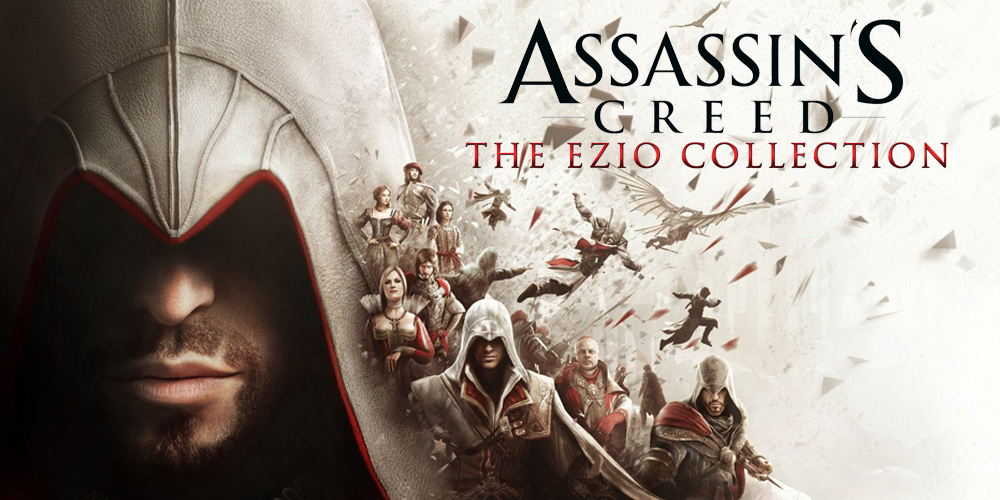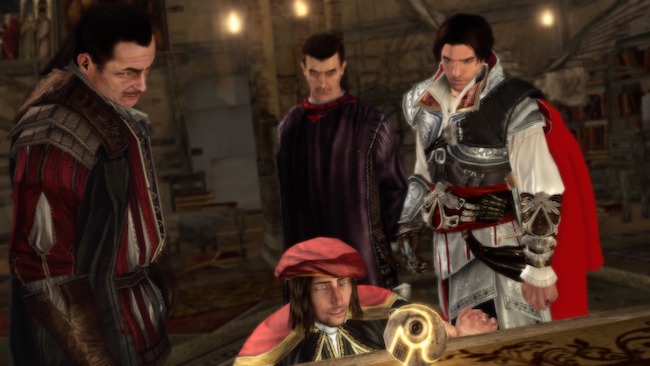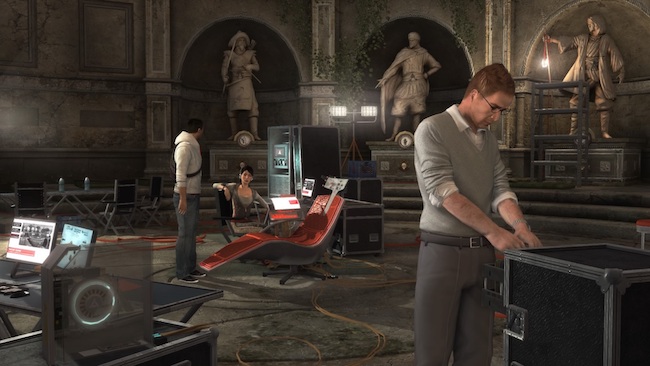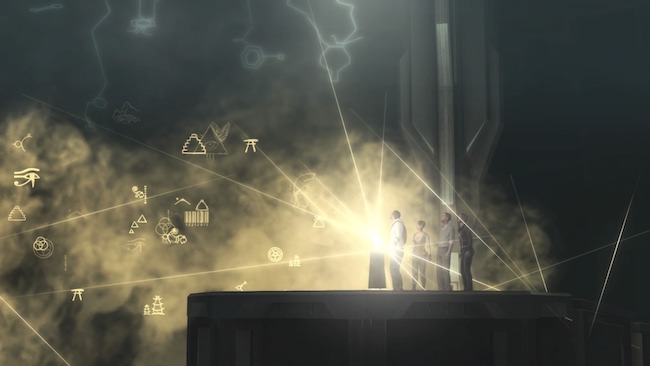
Ah, Assassin’s Creed. Since Ubisoft brought this world to us in 2007, I can’t even count how many hours I’ve spent in the various Animus… or is it Animuses? Animi? What’s the plural on that? Eh, doesn’t matter. One thing’s for sure, I’ve clocked up more hours than the protagonists have at this point. Hence, when the option to review Assassin’s Creed: The Ezio Collection showed up, I raised my hand. I’m basically a Master Assassin. This is going to be easy.
Oh man, let’s just say Desmond wasn’t the only one getting the “Bleeding Effect” at the end of all this.
Here’s the thing. I love Assassin’s Creed. It’s been a blast running and climbing through all the different time periods. Not a lot of games focus on those eras and certainly not to the degree that the Assassin’s Creed series has. Ubisoft have often gone above and beyond in making their worlds believable and accurate. There was a whole lot of places the developers could have taken the series after the first game and Renaissance Italy was a great pick. A story spanning decades and visiting fantastic cities such as Florence, Venice, Rome and Constantinople was an interesting idea. On the character front, while Ezio might not be my favourite lead, he definitely had one of the most complex stories and some of the best antagonists in the whole series. After all that, you’ve also got the incredibly well-handled conclusion of Altaïr’s story.

All these points made me very excited to jump into the Ezio Collection… and well, the shine wore off pretty damn fast. Which is insanely disappointing. The games themselves have been polished up remarkably, with Assassin’s Creed II getting the most work, probably because of its position in the series. Aside from some bug-eyed NPCs and the occasional blotchy skin texture, it’s a great overhaul. Brotherhood and Revelations received more improvements in their original versions, meaning they didn’t need as much work in this collection to update them. Visually, all these games are mostly on par with their PS4 and XBO companions, like Unity or Syndicate. However, that’s all there is to this collection.
There has been no work done to the games themselves, when there were so many opportunities to. I’m not saying remake the games, as it’s still too soon for something like that to happen, but while polishing up the graphics, little tweaks here and there wouldn’t have gone amiss. Simple things like applying the same NPC variety seen in Brotherhood to the cities in Assassin’s Creed II, but no, Venice is still full of massive hordes of grey clothed citizens, Forli is just endless brown rags, and so on. A button to skip cutscenes would have been wonderful, especially when you mess up on some sequences and get stuck watching them again and again. How about making Desmond’s face the same throughout all three games, instead of mimicking Ezio at each point in his life? It’s really disconcerting seeing the face of a twenty-something-year-old suddenly look like a man in his early fifties.
That’s one of the biggest gripes I have with this collection. In the original versions, there were two years between Assassin’s Creed II and Brotherhood and another year after that until Revelations, so the changes were less apparent. Now that they’re all together and you can play them one after the other, like I did, the differences between them are glaringly obvious. Some of them, like the user interface, are semi-explained whereas others, like Desmond’s scar disappearing, are just left untouched and are very immersion breaking when you spot them. If you don’t care for such things, they might slide by, but I spotted every one of them.

On the story side of things, everything is as it was in the original games. Beginning in Assassin’s Creed II with a hurried rush from Abstergo’s secret Animus training facility, Desmond and Lucy hightail it outta there and bunker down in a new little hidey-hole for Assassins, where we also meet series favourites, Shaun and Rebecca. Desmond spends the majority of the game inside the Animus, reliving Ezio’s campaign against the Borgia family and their Templar plans. Along the way, he stabs a bunch of Templars, chums around with Leonardo da Vinci and ultimately recovers a Piece of Eden, one of the glowing things that just ooze plot all over the place. After many years have passed, which you get to live through, Ezio is finally inducted into the Assassin’s Brotherhood.
Here’s another tweak I would have made, though. After everything the game has you do, all the completely transparent conversations about Ezio’s father being an Assassin, the weaponry, the outfit, being called assassino by literally every person in every city, the developers still had Ezio act surprised at the revelation that nearly everyone he’s been working with for over twenty years has been an Assassin all along. I mean come on, Mario Auditore, Ezio’s uncle, has the friggin’ creed logo right there on his tunic, and Monteriggioni, your base of operations, has both a gorgeous fountain sculpture of the logo and a massive sanctuary dedicated to fallen Assassins, containing the armour of Altaïr, the most revered Assassin to those of Ezio’s era. After all that is shown to us in the first few memory sequences of the game, it’s just such a slap in the face to a great character like Ezio to still apparently be so clueless after so many missions and assassinations over the years.
Moving on from that extremely peculiar moment, we reach the climax of the first game, where for reasons I still don’t really understand, Ezio decides not to do the one thing his title sort of expects him to do. Looking at it now, it’s obvious sequel bait and Ubisoft probably had a solid plan of where they wanted to go next, but at the time it was confusing and anticlimactic, given everything you had done to reach that point. It’s a weak story element, for sure, but it is more than redeemed by what comes next, which I’m not gonna speak about. Suffice to say, the ending of Assassin’s Creed II is just as mindblowing now as it was when I first played it and I urge you to see it for yourself.

After a basic wrap-up involving the antagonist from the first game, Warren Vidic, the Assassin gang depart their hidey-hole and the credits roll. Aside from the nearly endless collectables, mysterious glitch puzzles and six assassin tombs to complete that in the end grant you the armour in the sanctuary, there’s really nothing more to do except begin the next game.
Brotherhood picks up literally where Assassin’s Creed II left off, with Desmond and crew arriving at present day Monteriggioni and setting up shop in the previously mentioned massive sanctuary. It makes for a fun juxtaposition of the past and present, which surprisingly is even more effective in this collection. Ezio’s story inside the Animus also carries on immediately, with his actions at the end of Assassin’s Creed II earning him a revenge attack by Cesare Borgia, hands down contender for baddest badguy in the series. Not the kinda guy to take this sitting down, Ezio decides to take the fight to the Borgias once again, unseating them from their position of power in Rome.
There really isn’t much more to say about this part of the story, as the whole plot essentially boils down to recovering the Piece of Eden Cesare took during the attack. There’s a lot more involvement from Leonardo da Vinci and the war machines he was forced to build for the Borgias, which offered some very fun side missions, as well as a whole new set of secret tombs to wander through for another set of armour to wear. At the end of it all, though, you’re just on Cesare’s tail the whole way, contributing to or just watching as the Borgia family self-destructs from within. It’s compact and satisfying at many points, and along with the ability to now train and call into battle your own assasssin recruits, Brotherhood was the game I found myself enjoying the most because it was here I felt the most like an assassin. After Ezio’s crusade is done, we rejoin our modern day assassins for their climax, where even more surprising things happen and we roll credits once again.

Revelations, without giving too much away, picks up Desmond’s story shortly after the ending of Brotherhood, while Ezio’s tale jumps ahead a decade or two, into his fifties. Ezio is on the trail of Altaïr’s library, returning to Masayaf, the fortress from the first Assassin’s Creed game, to uncover the secrets of their order. An unnecessarily complicated plot kicks off involving very generic antagonists who, after the delightful bitterness and scheming of the Borgias, I just don’t care about.
Ezio strikes out across Constantinople, killing Templars and finding the keys to Altaïr’s library while also getting cosy with Sofia Sartor, a lady scholar who is in a very sweet way developed into a love interest. Apart from Sofia and Yusuf Tazim, one of my favourite assassins, nearly everything else in this game is a blink-and-you-miss-it sort of affair. The only thing you don’t want to miss are the memories Altaïr left behind, encoded in the keys that open his library. In some initially confusing moments, you the player find yourself living Desmond who is reliving Ezio, who is in turn reliving Altaïr during key points in his life. It’s some brain-bending stuff, but definitely a highlight of this game. The final memory is one of the best scenes I’ve seen in any video game, simultaneously closing the book on two characters in spectacular fashion.
That’s also where the book pretty much closes on these games, too. Apart from the horde of collectables across all three games, or maybe going for trophies or achievements, the replayability is unfortunately very limited. Where once the DLC would have brought you back, it’s now inserted into the narrative and you play it in order without realizing. The only bits that aren’t there are locked up in the Ubisoft Club store, bought with points you earn while playing the games, but they don’t really add all that much story wise. For that, you could investigate the loading menu where you select which game you want to play, as there are sections for Assassin’s Creed Lineage, the story of Giovanni Auditore, Ezio’s father, set immediately before the first game, and Assassin’s Creed Embers, the actual true ending for Ezio, set I think another decade after Revelations. I didn’t see an option to access these, so I’m assuming if you already have them or purchase them through your appropriate store, they become available through this menu. I just hopped over to YouTube, and an hour later, I had even more appreciation for the character and the world Ubisoft created for him.

One thing I will praise the Ezio Collection for is doing away with the multiplayer aspect of Brotherhood and Revelations. The original versions included a very confusing and frustrating hunter/killer kind of game mode where you play as Templars, supposedly in that Animus training facility that Desmond and Lucy escape from at the beginning of Assassin’s Creed II. While it was a fun way to link the multiplayer into the overall story, it didn’t really offer anything long lasting, and, frankly, I didn’t even notice it was gone until I was doing my post-game wrap-up.
So where does that leave me in this review? I’ve been praising the unaltered aspects of the original games, because they were great then and are still great now, while I’ve been ripping into what the Ezio Collection did not do. It’s a tough mix really. I would recommend this game to anyone who is not familiar with the Assassin’s Creed series, as it’s a great way to induct yourself into the mythos, but then, you’re missing out on the first game with Altaïr. I would not recommend this game to anyone who has played any of the ones that came after it, like myself, because oh man, it was so hard going back to the restrictive controls of these games after the incredible freedom of movement we’ve worked our way up to in Black Flag or Syndicate.
I nearly put the controller down for good quite a few times, just because Ezio did something unbelievably stupid or a whole free-running sequence went to hell because of a pathing glitch. The one thing that killed me the most through all three games was not the guards, or the Templars. No, it was the contextual camera. Seriously, the last time I raged so furiously at a camera in a game was in Super Mario 64, and, at least in that game, I could go into that mirror room and swear at Lakitu. In these games, it’s just the cold, unfeeling hand of death that reaches out and ruins you and you can’t do anything about it. A few camera tweaks or sensitivity adjustments to bring it closer to the much more refined feel of later games would have done wonders for the experience.

It feels like I’m raging about these games, but I also really want everyone to play them. For the full narrative, you’re going to need to grab the original Assassin’s Creed to understand where things start, but then you can move into the Ezio Collection quite easily and continue the tale afterwards in Assassin’s Creed III. If it was me in charge, though, I would have just made a Desmond Collection, dropping those other games in alongside Ezio’s, making the story complete and in one package.
What’s strange, though, is that Ubisoft already did that once, calling it the Anthology Collection. Why didn’t they just do that again, but shinier? It just feels like they said there were not going to be any new Assassin’s Creed releases in 2016, but then they very quietly hustled the Ezio Collection out the door like someone sneaking cheeseburgers into a cinema. It fills the spot a new Assassin’s Creed game would have occupied, but doesn’t do much overall for the brand and feels like a disservice towards the character and his legacy to repackage him so callously. They just missed a perfect opportunity to sneak some timely updates in, tweaks to improve the game, even expand upon elements of the story or characters, linking them even better to what comes in later Assassin’s Creed games. It could have been so cool.

Assassin’s Creed: The Ezio Collection is a great collection of games, but not because it’s a remaster. It’s a great collection because it’s got three great games inside it. Putting them together and adding a flashy menu and a coat of polish is only an effort to get new players interested. The games themselves are identical and offer nothing new to returning players except enhanced visuals. If that’s enough for you to get it, then great. For me, I was hoping for more, and it would have been so easy for Ubisoft to do more. I guess I’m just going to have to wait for the remaster of the remaster now. Until then, I hope Ezio will be allowed to requiescat in pace.











